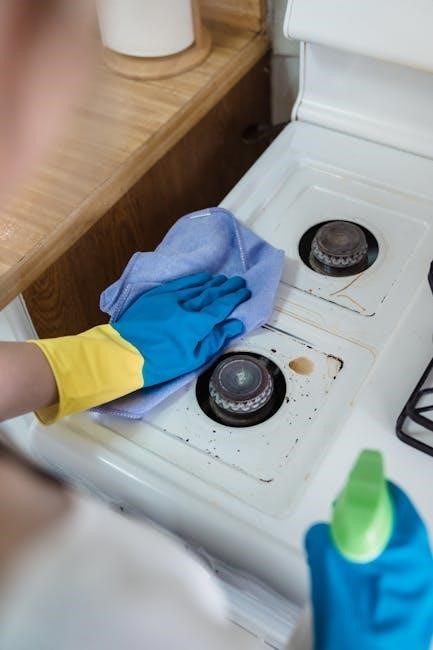Dirty Dozen Clean 15 PDF: A Comprehensive Guide
This guide explores the “Dirty Dozen” and “Clean Fifteen” lists, tools created by the Environmental Working Group (EWG) to help consumers make informed choices about produce purchases. The lists indicate pesticide contamination levels in fruits and vegetables.
The “Dirty Dozen” and “Clean Fifteen” are two annual lists created by the Environmental Working Group (EWG) that rank fruits and vegetables based on their pesticide residue levels. The Dirty Dozen highlights produce with the highest pesticide contamination, suggesting consumers purchase organic versions when possible. Conversely, the Clean Fifteen identifies produce with the lowest pesticide levels, implying that conventional options are relatively safe. These lists are updated yearly, reflecting the latest USDA testing data. The EWG began testing for pesticides in 2004, providing valuable insights for health-conscious shoppers to minimize pesticide exposure.
Understanding the Environmental Working Group (EWG)
The Environmental Working Group (EWG) is a non-profit organization dedicated to protecting human health and the environment. They conduct research and advocacy to inform consumers about potential hazards in everyday products.
EWG’s Role in Pesticide Testing
The Environmental Working Group (EWG) plays a crucial role in pesticide testing by analyzing data from the U.S. Department of Agriculture (USDA). Since 2004, the EWG has been testing fruits and vegetables to determine the number of pesticides found. This analysis helps them create the “Dirty Dozen” and “Clean Fifteen” lists, which highlight produce with the highest and lowest pesticide residues, respectively. These lists help consumers make informed decisions when purchasing produce, especially when organic options are limited or unavailable, promoting a healthier diet.
How the EWG Creates the Lists
The Environmental Working Group (EWG) compiles its “Dirty Dozen” and “Clean Fifteen” lists annually by analyzing pesticide residue data from the U.S. Department of Agriculture (USDA). The EWG looks at the number of pesticides found on each type of produce, considering factors like the frequency of pesticide detection and the average amount of pesticide residue. Produce with the most pesticide residues are placed on the “Dirty Dozen” list, while those with the least make up the “Clean Fifteen,” guiding consumers towards informed choices about conventional and organic produce.
The Dirty Dozen: Foods with the Most Pesticides
This section highlights fruits and vegetables that consistently show the highest levels of pesticide residue, according to the Environmental Working Group’s (EWG) analysis. Knowing these items can help you prioritize organic purchases.
Top 12 Fruits and Vegetables on the Dirty Dozen List
The Environmental Working Group (EWG) releases an updated “Dirty Dozen” list annually, highlighting the twelve fruits and vegetables found to have the highest levels of pesticide residue. In recent years, strawberries and spinach have frequently topped this list, along with leafy greens like kale, collard, and mustard greens. Other common entries include nectarines, apples, grapes, peaches, cherries, pears, tomatoes, celery, and potatoes. These items are recommended for organic purchase. Prioritizing organic options for these foods can significantly reduce pesticide exposure. The EWG’s testing reveals that these produce items consistently retain a concerning amount of pesticides, even after washing.
Why Buy Organic for Dirty Dozen Items?
Purchasing organic versions of “Dirty Dozen” fruits and vegetables is highly recommended due to the significant reduction in pesticide exposure. Conventional farming practices often involve the use of numerous pesticides, which can persist on the produce even after washing. These pesticides have potential health risks, especially for children and pregnant women. Choosing organic ensures that these items are grown without synthetic pesticides, herbicides, or fertilizers. While organic produce may be more expensive, the investment can be worthwhile to minimize your intake of potentially harmful chemicals. The EWG emphasizes that this choice helps protect your health and the environment.

The Clean Fifteen: Foods with the Least Pesticides
The “Clean Fifteen” lists fruits and vegetables with minimal pesticide residue. These items are generally safe to buy conventionally, offering a budget-friendly alternative to organic options while still prioritizing health.
Top 15 Fruits and Vegetables on the Clean Fifteen List
The Environmental Working Group’s (EWG) “Clean Fifteen” highlights produce with the least pesticide residue. This list can help save money while minimizing pesticide exposure. Common examples often feature thick outer layers that protect the edible parts. While the specific items may vary slightly each year, some frequently included examples are avocados, sweet corn, pineapples, onions, papayas, and sweet peas (frozen). Other produce such as asparagus, honeydew melon, kiwi, cabbage and grapefruit may also be included. Utilizing this list makes informed purchasing decisions easier when organic options aren’t feasible or accessible.
Saving Money by Buying Conventional Clean Fifteen Items
The “Clean Fifteen” list offers an opportunity to reduce your grocery bill without significantly increasing pesticide exposure. Since these fruits and vegetables typically contain minimal pesticide residue, opting for conventional varieties is a cost-effective choice; By strategically selecting conventional produce from the Clean Fifteen, you can allocate your budget towards purchasing organic versions of items on the “Dirty Dozen.” This approach allows you to prioritize organic purchases for produce with higher pesticide levels, maximizing your health benefits while managing expenses efficiently. Remember to always wash produce thoroughly, regardless of whether it’s organic or conventional.

Annual Updates and Changes to the Lists
The Environmental Working Group (EWG) updates the Dirty Dozen and Clean Fifteen lists annually. These updates reflect the latest pesticide testing data from the Department of Agriculture, ensuring the information is current and relevant for consumers.
Why the Dirty Dozen and Clean Fifteen Lists Change
The Dirty Dozen and Clean Fifteen lists are not static; they change annually due to several factors; Primarily, the United States Department of Agriculture (USDA) conducts regular pesticide residue testing on produce. The Environmental Working Group (EWG) analyzes this data to update its lists, reflecting current pesticide use and contamination levels. Changes in farming practices, pesticide regulations, and testing methodologies can all influence the rankings. Furthermore, the specific produce items tested each year may vary, leading to fluctuations in the lists. This ensures the guide remains relevant, providing consumers with the most up-to-date information for making informed decisions.
Accessing the Latest PDF Versions of the Lists
To ensure you have the most current information, accessing the latest PDF versions of the Dirty Dozen and Clean Fifteen lists is crucial. The Environmental Working Group (EWG) website is the primary source for these updated guides. Typically, the EWG releases a new version annually. You can visit their website, navigate to the “Shopper’s Guide to Pesticides in Produce” section, and download the PDF directly. Many websites offer the PDF for download, but it’s best to go to the source. This PDF is easily printable and shareable, allowing you to keep a copy on hand while shopping for produce or on your phone.
Benefits of Using the Dirty Dozen and Clean Fifteen Guides
Using these guides empowers informed decisions about produce purchases. Prioritizing organic options for the “Dirty Dozen” minimizes pesticide exposure, while saving money by buying conventional “Clean Fifteen” items is possible.
Making Informed Choices About Produce Purchases
The “Dirty Dozen” and “Clean Fifteen” lists are valuable resources for consumers seeking to minimize pesticide exposure. These guides, updated annually by the Environmental Working Group (EWG), reveal which conventionally grown fruits and vegetables tend to have the highest and lowest pesticide residues, respectively. By consulting these lists, shoppers can prioritize organic options for items on the “Dirty Dozen,” reducing their intake of harmful chemicals. Conversely, they can confidently purchase conventional versions of “Clean Fifteen” produce, saving money without significantly increasing their pesticide exposure. These lists promote healthier and more budget-conscious decisions.
Balancing Cost and Health Considerations
Grocery shopping can be a balancing act between health concerns and budget constraints. The “Dirty Dozen” and “Clean Fifteen” lists help navigate this challenge by offering practical guidance. Prioritizing organic purchases for “Dirty Dozen” items minimizes pesticide exposure, a worthwhile investment in health. Choosing conventional options from the “Clean Fifteen” list allows for cost savings without significantly increasing pesticide intake. This strategic approach enables individuals and families to make informed decisions that align with both their health goals and financial resources. The lists empower consumers to optimize their produce choices, promoting well-being without breaking the bank.

Washing Produce: A Universal Recommendation
Regardless of whether produce is organic or conventionally grown, washing is crucial. Washing helps remove dirt, bacteria, and pesticide residues, contributing to safer consumption and better overall health for everyone.
Importance of Washing All Fruits and Vegetables
Washing all fruits and vegetables, irrespective of their appearance on the Dirty Dozen or Clean Fifteen lists, is a vital step in food safety. Even produce with low pesticide residue can carry dirt, bacteria, and other contaminants acquired during handling and transportation. Thorough washing minimizes the risk of ingesting harmful substances. It is still recommended that you thoroughly wash all produce before consuming it, whether its organic or not, Dirty Dozen, or Clean Fifteen. Remember to prioritize produce washing for better health.
Best Practices for Washing Produce
To effectively wash produce, begin by rinsing it under cool, running water. For items with thicker skins, use a scrub brush to remove dirt and debris. Consider using a produce wash for enhanced cleaning, following the product’s instructions. Avoid using soap or harsh detergents, as they can leave harmful residues. Dry the produce with a clean cloth or paper towel after washing. This helps remove any remaining contaminants. Washing helps to minimize the risk of ingesting harmful substances. Remember to prioritize washing produce for better health.

Beyond the Lists: Organic vs. Conventional Farming
This section explores the fundamental differences between organic and conventional farming practices. It highlights the impact of pesticides on both human health and the environment, offering a broader perspective beyond the “Dirty Dozen” and “Clean Fifteen”.
Differences Between Organic and Conventional Agriculture
Organic farming prioritizes natural methods, avoiding synthetic pesticides and fertilizers. It emphasizes soil health, biodiversity, and sustainable practices. Conventional agriculture often relies on synthetic inputs to maximize yields, potentially leading to pesticide residue on produce. Organic farming aims to minimize environmental impact and promote ecological balance, whereas conventional farming focuses on efficiency and large-scale production. Choosing organic helps to support farming practices that are less harmful to the environment and potentially better for your health, based on current research.
The Impact of Pesticides on Health and the Environment
Pesticide exposure can pose health risks, especially to children, pregnant women, and those with compromised immune systems. Potential health effects include neurological problems, hormone disruption, and increased cancer risk, depending on the specific pesticide and level of exposure. Environmentally, pesticides can contaminate soil, water sources, and harm beneficial insects, birds, and other wildlife. The Dirty Dozen list highlights produce with higher pesticide residues, prompting consideration of organic alternatives to minimize potential health and environmental consequences. Choosing produce with lower pesticide levels is a responsible decision.
Accessing the Dirty Dozen and Clean Fifteen PDF
The Environmental Working Group (EWG) provides free, downloadable PDF versions of the Dirty Dozen and Clean Fifteen lists on their website. These PDFs can be easily accessed for convenient reference while shopping.
Downloading and Printing the Lists
Acquiring the Dirty Dozen and Clean Fifteen lists is straightforward. Visit the Environmental Working Group’s (EWG) official website to locate the most recent “Shopper’s Guide to Pesticides in Produce.” From there, you can easily download the PDF version of the lists. Once downloaded, the document can be printed for convenient access during grocery shopping trips. Printing allows you to have a physical copy readily available, eliminating the need to rely on electronic devices in the store. Keep the printed list handy in your wallet or purse for quick reference when selecting your fruits and vegetables.
Using Digital Versions on Mobile Devices
For tech-savvy shoppers, accessing the Dirty Dozen and Clean Fifteen lists on mobile devices offers unparalleled convenience. Download the PDF from the EWG website and save it to your phone or tablet for instant access while shopping. Alternatively, consider using note-taking apps to create a digital checklist of the lists. Many apps allow you to mark items as you shop, ensuring you stay informed about pesticide levels. Some third-party apps specifically designed for healthy shopping also incorporate the Dirty Dozen and Clean Fifteen data. These apps can provide additional information and recommendations, further empowering your purchasing decisions.

Leave a Reply
You must be logged in to post a comment.